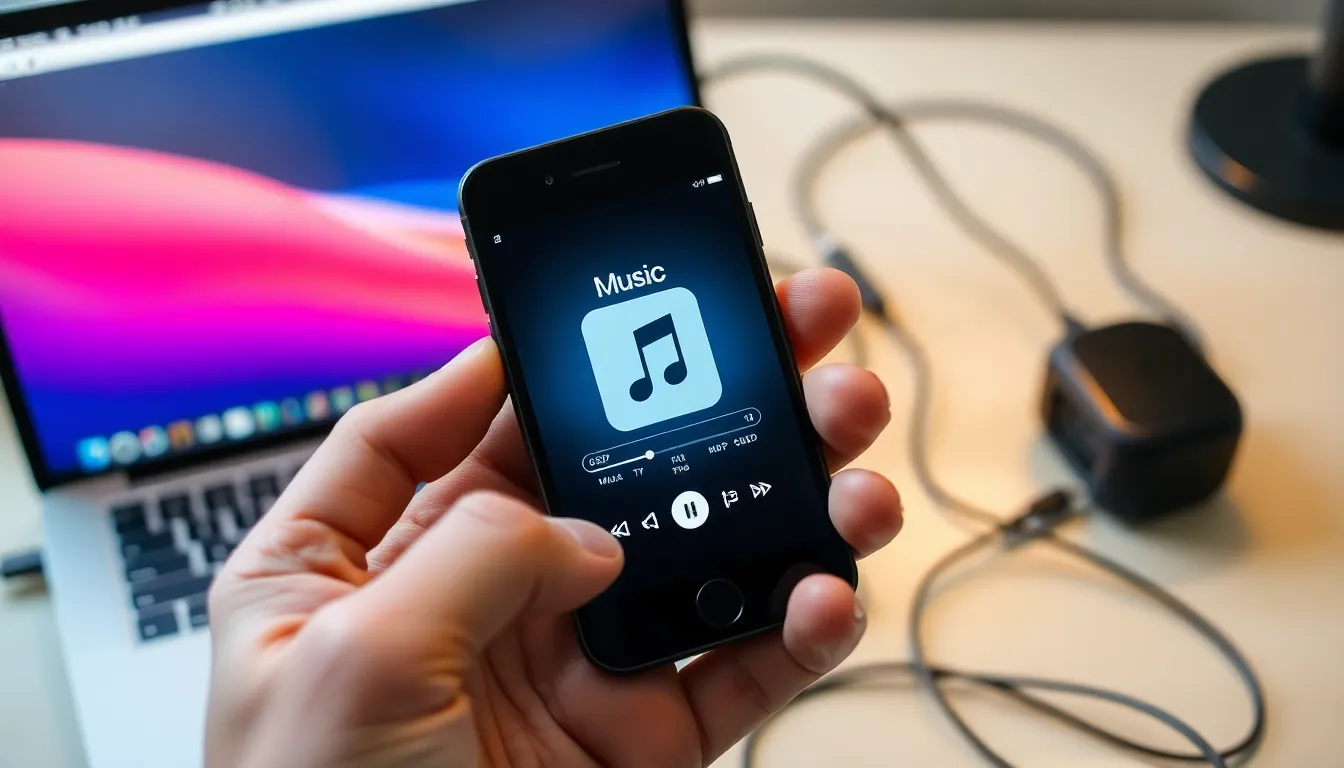Imagine this: you’ve got a killer playlist ready to go, but your iPhone seems to have other plans. It’s like trying to fit a square peg in a round hole. But fear not! Playing MP3 files on your iPhone is easier than convincing your cat to come when called.
Table of Contents
ToggleUnderstanding MP3 Files
MP3 files represent a widely used audio format. Developed by the Moving Picture Experts Group, this format compresses sound data while maintaining quality. Compression reduces file size, making it easier to store and share music or audio recordings.
Compatibility remains a key feature of MP3 files, allowing playback on various devices. Most smartphones, computers, and media players support this format, ensuring accessibility for users. iPhones specifically recognize MP3 files, letting users enjoy music without unnecessary conversions.
Quality of sound in MP3 files varies depending on bit rate. Higher bit rates, like 320 kbps, produce clearer audio, while lower ones, such as 128 kbps, may reduce sound fidelity. Users often select their desired balance between file size and audio quality based on personal preferences.
Convenience of MP3 files enhances the overall listening experience. With features like playlists and ability to create libraries, users can easily organize and access their favorite tracks. Furthermore, MP3 files support metadata, which includes song titles, artist names, and album information. This organization helps streamline music collection management.
Availability of MP3 files is extensive. Users can purchase music from online stores, download songs from various platforms, or convert audio from CDs into MP3 format. As a result, options for acquiring MP3s grow, allowing listeners to build diverse music libraries on their iPhones.
Understanding these key aspects of MP3 files equips users to maximize their listening enjoyment on their devices. There’s an array of resources and tools available to help streamline the process, making it easier than ever to play MP3 files on an iPhone.
Transfer Methods for MP3 Files

Playing MP3 files on an iPhone involves several straightforward transfer methods. Users can choose from iTunes, third-party apps, or cloud services to seamlessly enjoy their audio content.
Using iTunes
iTunes serves as a primary tool for transferring MP3 files. Users connect their iPhone to a computer using a USB cable, then launch iTunes. Adding MP3 files is simple; just drag and drop them into the library. Syncing occurs by selecting the device in iTunes and clicking the “Sync” button. Once completed, users can locate their MP3 files in the Music app on their iPhones.
Using Third-Party Apps
Many third-party apps facilitate MP3 transfers to an iPhone. Popular choices include VLC for Mobile and Documents by Readdle. Users can upload MP3 files directly from their computers or import them from cloud services. Once in the app, playing MP3 files becomes easy with built-in audio players. These apps often support playlists and additional features that enhance the listening experience.
Using Cloud Services
Cloud services provide a convenient alternative for accessing MP3 files. Popular options such as Google Drive and Dropbox enable users to upload audio files online. Accessing these files on an iPhone requires downloading the respective cloud app. After logging in, users can stream or download their MP3 files directly to their device. This method allows for easy management of audio files without needing physical transfers.
Playing MP3 Files on iPhone
Playing MP3 files on an iPhone offers several straightforward methods that enhance the user experience. Each approach allows seamless access to audio content.
Using the Music App
The Music app on an iPhone simplifies MP3 playback. Users can sync their MP3 files through iTunes, creating a library directly accessible on their devices. Once synced, individuals find MP3 files organized under “Songs” or specific playlists. They can easily search for tracks by artist, album, or genre. Sound quality remains consistent, allowing for enjoyable listening experiences.
Using Third-Party Music Players
Third-party music players expand MP3 playback options significantly. Applications like VLC for Mobile or Documents by Readdle enable users to play files not managed by the Music app. Downloading these apps from the App Store is simple. After installation, users can upload their MP3 files through Wi-Fi, cloud services, or direct transfers from computers. These apps often support additional formats, providing versatile audio playback capabilities.
Troubleshooting Playback Issues
Playback issues can arise when trying to play MP3 files on an iPhone. Identifying the problem helps in finding effective solutions.
Common Problems and Solutions
Incompatibility of file formats leads to playback failure. Ensure that the file is in MP3 format since other formats may not play. Missing metadata can affect organization in the Music app. Users should add or edit metadata to facilitate better access to songs.
Another common issue involves sync problems with iTunes. If files don’t appear on the iPhone, recheck the sync settings in iTunes. Adjusting the sync preferences might resolve the issue.
Playlist discrepancies could occur if items aren’t synced. Verifying that the playlists in iTunes match those on the device helps in maintaining consistency.
Insufficient storage space presents another complication. Users can check available space via Settings, then clear unwanted files to free up storage. These steps assist users in ensuring smooth playback of their MP3 files on an iPhone.
Playing MP3 files on an iPhone can be straightforward and enjoyable. With the right tools and methods users can easily transfer and access their favorite audio tracks. Whether utilizing iTunes third-party apps or cloud services the options available cater to various preferences and needs.
By organizing music through playlists and ensuring files are properly formatted users can enhance their listening experience. Troubleshooting common playback issues further ensures that enjoyment isn’t interrupted. With these tips in mind anyone can transform their iPhone into a powerful music hub ready to deliver high-quality audio on the go.




